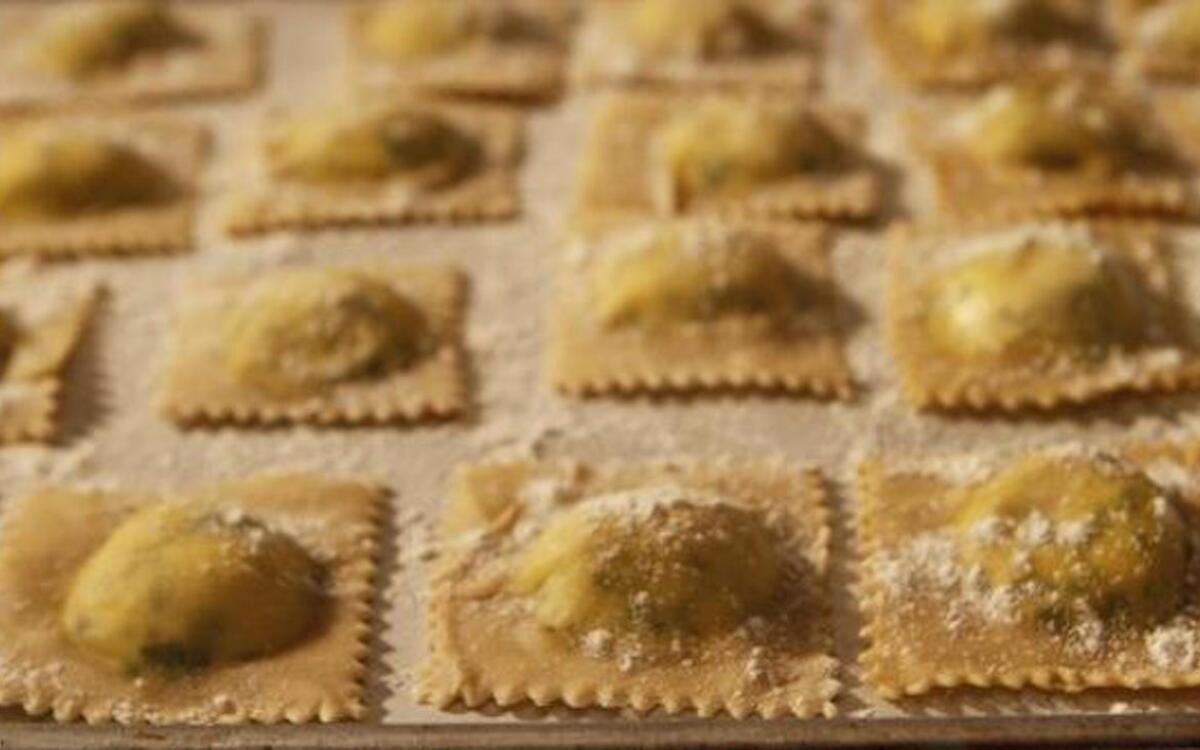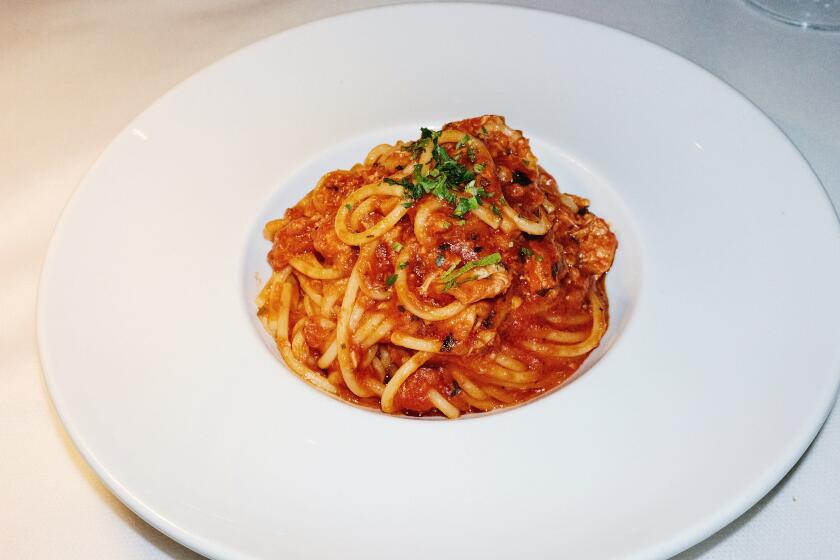Goat cheese ravioli

Here in California we love to brag about our abundance of wonderful seasonal ingredients and how that makes good food easy. Thatâs more or less true, but I have to confess that Iâve also always had a sneaking admiration for those cooks who can whip up something from nothing.
Sure, itâs wonderful to be able to just pick up a sack of Ojai Pixie mandarins and a box of medjool dates and call it dessert. But youâve really got to admire someone who can take a couple of wilted zucchinis, a sprouting onion and some canned tomatoes and turn that into something delicious -- the real-life equivalent of the proverbial stone soup.
Iâve got my own version, and, in fact, it does start with something hard as a rock. In a battered plastic bag in the deepest recesses of my refrigerator, Iâve got a hidden stash of gold: rinds from used chunks of Parmigiano-Reggiano. Whenever my wife finds them, she pulls them out and asks disbelievingly: âYouâre saving these?â And probably 98% of people would have the same reaction.
But those rock-hard rinds are flavor bombs, packed with umami. Simmer them in a pot of beans, in a soup, even in a tomato sauce, and you probably wonât actually taste Parmesan, but youâll certainly taste the difference.
Those rinds can also take on a more starring role. One of the trending preparations in restaurants right now is Parmesan broth -- at its essence, simmered Parmesan rinds. It makes a wonderful light sauce with a subtle nutty, buttery flavor that serves as a complementary backdrop to all kinds of spring dishes.
Thereâs a little more to it than simply boiling rinds, of course. I start mine with a combination of chicken broth and water -- half and half is a good starting point. Most canned stocks and broths are better appreciated for the flavors they imply rather than the ones they actually possess. And in this case, even a good homemade stock would be too strong by itself. You want to taste the cheese, not the chicken.
With that I simmer some sliced garlic and a handful of whatever herb trimmings I have from prepping the other ingredients. Again, this is an Italian-style broth, meant to be subtle.
Itâs not quite something from nothing, but it comes pretty close.
Parmesan broth
The best thing Iâve made with Parmesan broth recently was a kind of cross between a stew and a pasta that paired goat cheese ravioli and spring vegetables. I used asparagus tips and sugar snap peas for this recipe, but Iâve also made similar dishes with English peas, fava beans, shaved radishes and even bolted lettuce from the garden.
The only part thatâs even a little tricky is making the ravioli. If that intimidates you (and it shouldnât ... it takes less than an hour of work and itâs actually really fun), you could substitute quadrati -- little fresh pasta squares; make them beautiful by including leaves of fresh herbs on the last turn of the dough.
Gnocchi would work too, but if you insist on dried pasta, use tiny orzo or stelline. This dish emphasizes delicacy; any of the chewier shapes would be out of sync. Cook them separately so they donât cloud the broth.
Most everything can be prepared in advance, so only a few minutes of cooking are needed just before serving. Make the Parmesan broth and the goat cheese ravioli. Prepare and blanch the vegetables.
Then at the last minute reheat the broth and bring a wide pot of water to a boil. Cook the ravioli and divide it among warm pasta bowls. Reheat the blanched vegetables in the same water and arrange them over the ravioli. Ladle over some broth and sprinkle with chopped chives and a little grated Parmesan to finish.
In a food processor, mix the flour and 2 eggs until it just comes together to form a rough dough. If that doesnât happen, add a little more beaten egg, a teaspoon or so at a time. Remove the dough to a floured work surface and knead until it is smooth and elastic, about 5 minutes. Wrap with plastic wrap and refrigerate at least 30 minutes to relax the gluten.
In a mixing bowl, beat together the fresh goat cheese, Parmigiano-Reggiano, egg yolk, chives and parsley. Taste and add more salt if necessary.
Divide the dough into 4 equal parts. Work with one one piece at a time, keeping the remainder covered in plastic. Flatten the dough with your hand and then pass it through the widest setting of a pasta machine, folding the dough into thirds after the first time, and repeating until you make a thick sheet approximately 5 inches wide. Continue putting the dough through each setting, finishing with the second-to-thinnest setting; the sheet should be 6 1/2 to 7 inches wide. Lightly dust the machine or dough with flour if it sticks. The pasta will be very thin and almost translucent. Lay the pasta sheet on a floured surface.
To fill the pasta, place a small (2-teaspoon) mound of filling at 3-inch intervals, 1 inch from the edge, along the length of the pasta. Use a pastry brush or your finger to paint lightly around each mound with beaten egg white.
Fold the pasta over the filling lengthwise, making sure thereâs at least one-half inch from the edge of the fold to the beginning of the filling. Press down along the back edge with the side of your thumb to seal. Press between each mound of filling to seal the sides, then press along the front to make the final seal.
With a ravioli cutter, cut around the pasta to form a decorative edge, then cut between the filling, always front to back, to form the ravioli. Place the pasta on a baking sheet lined with a cotton dish towel sprinkled with flour. Repeat with the remaining pasta. If you make these early in the day, turn them over from time to time so they dry evenly.
Get our Cooking newsletter.
Your roundup of inspiring recipes and kitchen tricks.
You may occasionally receive promotional content from the Los Angeles Times.
















